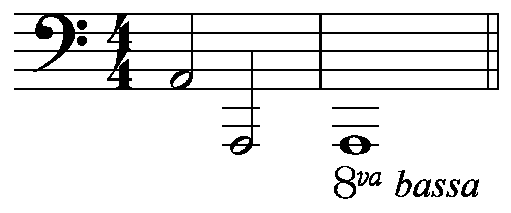
2.1. The full gamut of the musical scale is divided into so-called octaves, each octave comprising the notes from any C to and including the B next above. These octaves are numbered, beginning with the lowest C on the piano, and the pitch of a note is shown by preceding it, when required, by the particular sign for the octave in which it stands.
The rules governing the use of octave signs are of the greatest importance.
2.1.1. As will be seen in Table 2, the octave sign is placed immediately before the note to which it belongs, and no other sign may come between them.
2.1.2. The octave is always marked at the beginning of a paragraph or piece, and at various other points which will be mentioned later (Sections 8, 20, etc.).
2.1.3. In a melodic progression, the octave is not marked for the second of two consecutive notes if it is less than the interval of a fourth from the first.
Example 2.1.3-1.
"DFH[D EGIJEG FHJDIG EJHGEJ
"\G:F N'<K

(See also Example 2.3-1.)
2.1.4. The octave is always marked in a skip of a sixth or seventh, even when the second note is in the same octave as the first.
Example 2.1.4-1.
"DFHI"D"I "D<"J"D"I"D"I R'<K

2.1.5. The octave is only marked in a skip of a fourth or fifth when the second note is in a different octave from the first.
(Compare (a) and (b) in the following example.)
Example 2.1.5-1.
#C4

(b) "HIJH.D"H .E"H.P<K

The 8va
2.2. In non-facsimile transcriptions, the words 8va and loco (or their equivalents) are represented by transcribing the correct pitches an octave higher or lower as indicated.
In facsimile copy, these indications are transcribed as words, or the following method may be used.
2.3. The first note of the passage so marked is given two octave signs, the first showing its position on the print staff, the second its actual sound. Any octave sign occurring during this passage must be that of the sound and not that of the staff. The first note after the end of the passage is given a double octave mark to show that its position on the staff corresponds with its actual sound. These special octave markings must be given even when the notes would not otherwise need octave signs according to Par. 2.1.3 and 2.1.5 above. Example 2.1.3-1 if transcribed exactly according to the print would therefore be written thus:
Example 2.3-1.
"DFH[D EGI".JEG FHJDIG EJ..HGEJ
"\G:F N'<K

It is not necessary to use this device for isolated notes or chords below the first or above the seventh octave.
Example 2.3-2.
^S@S @@!<K
